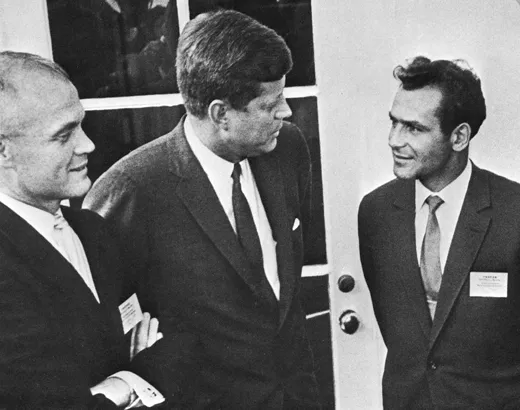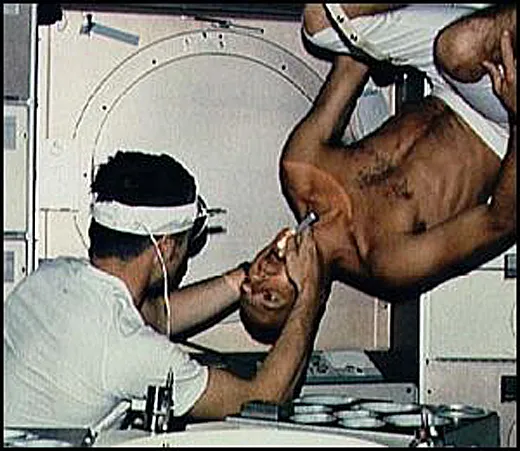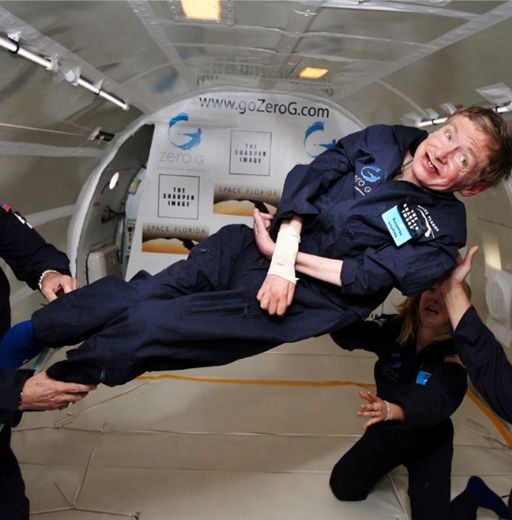Sick in Space
It’s not just a problem for astronauts anymore.
/https://tf-cmsv2-smithsonianmag-media.s3.amazonaws.com/filer/spacesick-flash.jpg)
Poor Gherman Titov, the second human in orbit. By the time the Soviets flew him in August 1961, Yuri Gagarin had grabbed the glory four months earlier. Unlike Gagarin, who had made just one orbit, Titov was subjected to 17, which took a little more than a day. That might have granted the kid bragging rights—he was 25 years old, and remains the youngest person ever in space. But after a few orbits, Titov suddenly grew nauseous, and then—horror of horrors for any military pilot turned cosmonaut—he threw up. It looked like a rookie problem, but Sergei Korolyov, the legendary engineer who headed the Soviet space effort, took it very seriously.
“Korolyov shut down the manned spaceflight program for a year,” says Chuck Oman, a neuroscientist at the Massachusetts Institute of Technology. “They didn’t know what they were dealing with. At first they wondered if it was triggered by some central nervous system reaction to fluid shift in the body. Later, we found that wasn’t true. But when you go to orbit, you do change the rules. Humans are fundamentally flatlanders. Even though you’re not standing on the surface, the brain wants you to have one.”
For the better part of three decades, Oman has been working with NASA to understand the neurophysiology behind space adaptation syndrome, or space sickness—the malaise, disorientation, dizziness, and outright nausea that harass most astronauts during the first few days in orbit. As director of MIT’s Man Vehicle Laboratory, a group within the institute’s Center for Space Research, Oman has accumulated plenty of data that almost guarantees it: If you plan to go to space, get ready to feel crummy for a few days.
Oman’s work is worth a fresh look as orbital tourism companies like Space Adventures send increasing numbers of the super-rich up to the International Space Station—Virgin Galactic will soon send clients on suborbital rocketplane flights for $200,000 each, promising several minutes of weightlessness. Already, a company called Zero Gravity offers anyone who can part with $5,000 the adventure of 30-second floats inside a Boeing 727 during parabolic flights—repeated steep climbs alternating with steep drops. For some customers, after the 15th or so parabola, along with the sweet taste of weightlessness comes the bitter taste of something else. As zero-g comes to the masses, it pays to know the ground rules of space sickness. The two biggest are 1) consider taking anti-nausea drugs, and 2) keep your head still.
Alan Ladwig, a senior advisor in NASA’s Office of the Administrator, co-founded Zero Gravity. First of all, he hates the term “vomit comet.” “We’ve never used that phrase,” he says. “That’s something the journalists gravitate to. It sends the wrong signal.” He claims that the trick to enjoying a zero-g flight is to have a little protein in your stomach, a little fruit, and crackers. Visit your doctor first and talk about the right anti-nausea medication. And once the parabolas begin, have fun. Most of all, he says, lie down flat on your back each time the plane pulls out of a weightless phase. “It’s not the floating by itself that makes you nauseous,” he promises. “The problem occurs during the two-G pullout. And moving the head during pullout is a big no-no.” Future suborbital parabola fliers on rocketplanes will feel a higher, more sustained G-load during reentry, but will be strapped on their backs in reclining seats.
Space sickness didn’t afflict the Mercury and Gemini astronauts—if it did, they weren’t talking. All the early astronauts were hyper-secretive about perceived physical ailments that might give doctors reason to ground them. Also, researchers believe that the tight cockpits of those vehicles didn’t allow astronauts to float around enough to trigger sickness.
Apollo was a different story. The crew of Apollo 7, the first manned flight of the roomier three-seat capsule that allowed some free floating, reported having bad colds in space. But some now say that commander Wally Schirra, along with Donn Eisele and Walter Cunningham, all suffered something else. “Apollo 7, it was space sickness,” says NASA’s Millard Reschke, who studies the problem at the agency’s Life Sciences Research Lab at the Johnson Space Center in Houston. “No doubt about it. The excuses just don’t hold up.” On the next flight, Apollo 8 commander Frank Borman was suddenly overcome with vomiting and diarrhea mere hours into the flight. Apollo 9’s Russell Schweickart endured days of misery from space sickness.
It may be a coincidence that these five men never flew again with the space program. But with moon landings about to happen, Apollo crews clammed up about the problem until years later when astronauts such as Apollo 11’s Michael Collins and Apollo 17’s Jack Schmitt admitted to feeling the butterflies of space sickness during their flights.
“Just because the Apollo guys didn’t report it doesn’t mean they didn’t feel it,” says former astronaut Owen Garriott. “They had a job to do and needed to press right ahead. But I do think the majority of the Apollo people felt it.”
Then came Skylab in 1973-74, when three crews of three astronauts each lived in Earth orbit aboard a modified third stage of a Saturn V rocket. About 20 feet by 30 feet, it was a gymnasium compared to anything that had preceded it. Garriott, who went up with the second group, remembers that even seasoned moonwalkers like his commander, Apollo 12’s Alan Bean, couldn’t hide their space sickness in the cavernous interior. His other crewmate Jack Lousma lost his lunch on day one. “Lousma was the worst of us, because his job was to be the first one into the big-volume dome of the orbital workshop.” Garriott claims his own adjustment took a few days. “We slowed down and tried not to work so hard. Tried not to move around so much.”
Oman claims that Skylab forced the issue. “Five out of nine got sick,” he says. “So NASA said, ‘Whoa, this is not some strange disease of Russian cosmonauts.’ ” Crew members on board Salyut, the Soviet space station, had been dealing with similar problems, he says. “Then space motion sickness came out of the closet in the first 50 shuttle missions.”
On Garriott’s next spaceflight, aboard space shuttle STS-9, which carried the large-volume Spacelab-1 in its cargo bay, he was first in after the vehicle reached orbit. He met the same fate as Lousma a decade earlier. “The adjustment was similar, except that I threw up, which I didn’t do on Skylab,” he says.
The simplest explanation for space sickness mirrors that of car sickness. It’s a sensory conflict in which the semicircular canals and otolith organs of the inner ear, which make up the vestibular system, tell you one thing—for example, that you’re moving—while your eyes, fixed on a book in the car or an instrument panel in the shuttle, tell you that you’re standing still.
A fundamental difference is that in a moving car, or even in the high performance T-38 supersonic jet that astronauts use to train, you’re still subject to Earth’s one-G pull. In orbit, you’re in continuous freefall, which just can’t be duplicated on Earth. People who can tolerate motion sickness on Earth sometimes suffer the most from space sickness. And the common pale face that precedes a bout of retching on Earth doesn’t happen in space because of the fluid shift upward.
There are few good predictors of who will suffer space sickness. But statistics show that between 70 percent and 90 percent feel it in some form on the shuttle, and about one in ten suffer severe symptoms including retching. Senator Jake Garn became the poster child of the puking shuttle flier on STS-51D in April, 1985, and astronauts now jokingly use the “Garn Scale” to rate their own severity.
Oman claims that vision plays a complex role in space sickness. “What seems to be happening in weightlessness is that when you put your feet toward the ceiling, something fundamentally changes. Your brain says, ‘Wait, that’s supposed to be the floor down there.’” Like the famous Necker Cube perception riddle, the orbiting brain goes through a series of visual illusions during its first days in orbit.
Medical doctor and two-time shuttle flier Bill Thornton, who got sick to his stomach on his first flight, STS-8, takes a scientific view of the process, calling it a “beautifully self-limiting adaptation” to an unusual environment. “Neuro-vestibular adaptation is an ancient evolutionary adaptation that conferred Darwinian survival advantages to our ancestors,” he assures, “especially to our arboreal ancestors. It’s a two-part process. The obvious component, miscalled sickness, protects the organism by more or less immobilization; while the second component, an individual adaptation, takes a day or so to reprogram components of the nervous system to allow for safe and effective activity in weightlessness.”
He admits that it tends to sneak up on you. “The first inclination you have is that you vomit your tonsils up in a couple heaves. I went on and on for about 36 hours. Then it was over, and I could do snap rolls and all the other tricks. So I had an invaluable firsthand experience.”
For some professional astronauts, the answer lies in taking antihistamines like promethizine (Phenergan), and scopalamine. But opinions are mixed about their risks. They cause drowsiness that some astronauts would rather avoid, even if it means gritting one’s teeth through a few days of space sickness. Many astronauts try to keep their heads as still as possible for the first 48 hours of a spaceflight, and definitely avoid the mirthful tumbling seen in countless film clips from orbit. Many shuttle commanders encourage their crews to remain upright with respect to each other and to any wall displays for the first few days of a flight.
Space tourism promoters may some day give similar advice to passengers bound for orbiting hotels. And if the bag has to be used, make it a good seal.



